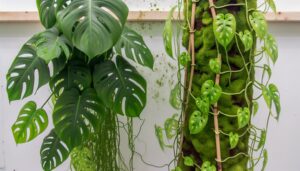How to Propagate Monstera Dubia
To propagate Monstera dubia, select a healthy parent plant, avoiding any with signs of Phytophthora spp. or Pseudomonas spp.
With sterilized pruning shears, cut 4-6 inch stem sections containing a node and aerial root. For water propagation, submerge the node in dechlorinated water, changing it every 5-7 days.
Alternatively, plant the cutting in a well-draining orchid mix, maintaining 60% humidity and temperatures between 20-25°C. Monitor for root growth over 4-6 weeks.
Support its climbing habit with a moss pole or wooden plank. For deeper insights on caring for new plants and troubleshooting, continue.
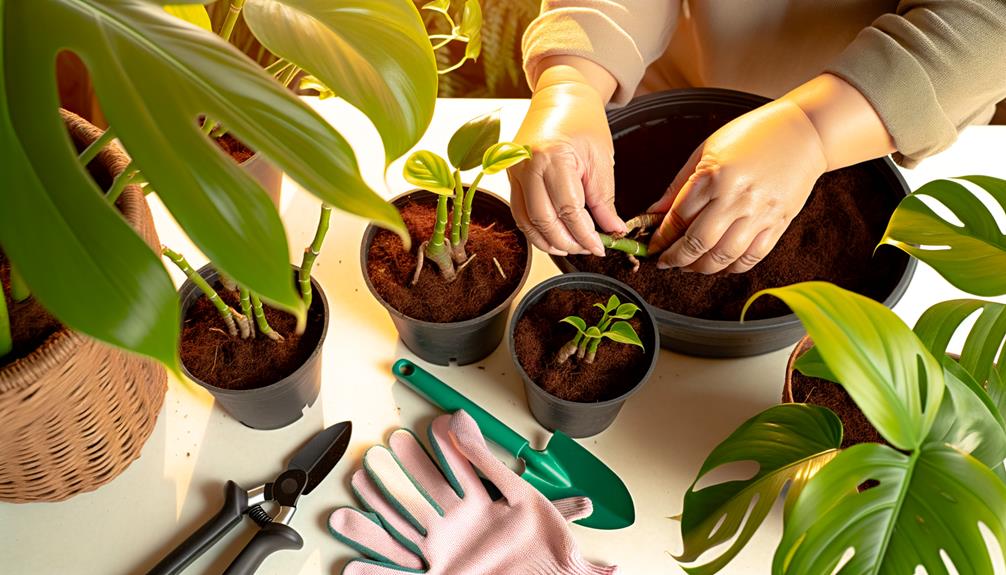
Key Takeaways
- Choose healthy parent plants with robust roots and vibrant, undamaged foliage.
- Take cuttings with at least one node and a healthy leaf, ensuring stem segments are green and firm.
- Use sterilized cutting tools to make 4-6 inch cuttings, including aerial roots if possible.
- Root cuttings in dechlorinated water, changing the water every 5-7 days, or in well-draining potting mix.
- Maintain high humidity, bright indirect light, and a temperature range of 20-25°C for optimal root development.
Understanding Monstera Dubia
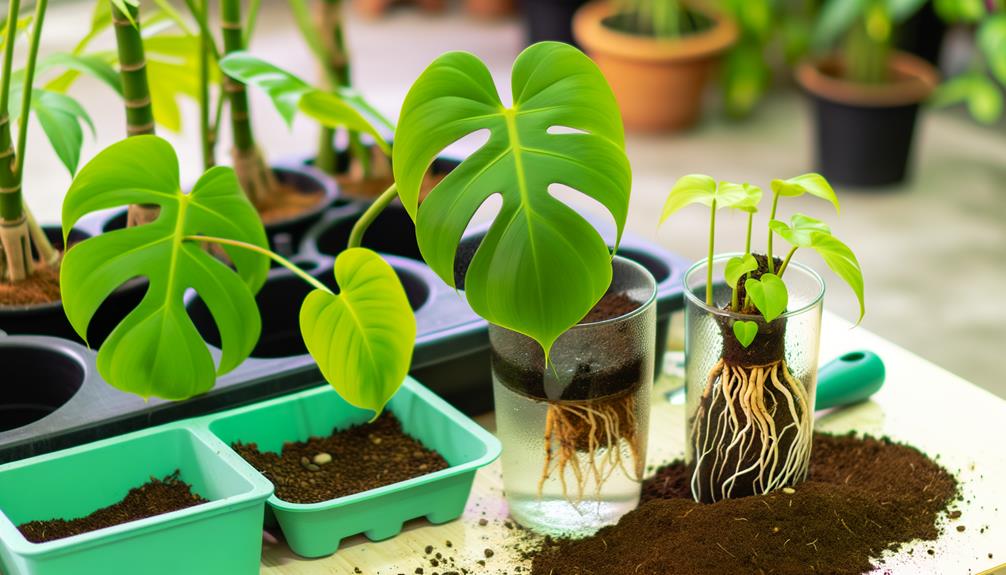
Understanding Monstera dubia involves recognizing its unique climbing behavior and distinct fenestrated leaves that distinguish it from other Monstera species. Monstera dubia, native to Central and South America, exhibits an epiphytic growth habit. It attaches itself to trees using aerial roots, climbing upwards to access light.
As it matures, its juvenile leaves transform from small, heart-shaped, and solid green to larger, fenestrated forms.
To properly identify Monstera dubia, observe the leaf morphology and climbing pattern. Juvenile leaves are typically 5-10 cm long, while mature leaves can exceed 20 cm with pronounced fenestrations.
Make sure your climbing support mimics natural tree bark to facilitate attachment. By grasping these characteristics, you'll be equipped to provide the ideal environment for your Monstera dubia's growth.
Gathering Necessary Supplies
To assure your Monstera dubia thrives, you'll need to gather specific supplies tailored to its epiphytic nature and climbing tendencies. Start with a well-draining potting mix, ideally an orchid mix (e.g., bark, perlite, sphagnum moss). Next, secure a moss pole or a wooden plank for its aerial roots to cling to. Make sure you also have sterilized pruning shears to make clean cuts for propagation.
Here's a concise table to guide you:
| Supply | Purpose | Notes |
|---|---|---|
| Orchid Mix | Provides drainage/aeration | Mix of bark, perlite, sphagnum moss |
| Moss Pole/Wooden Plank | Supports climbing/epiphytic growth | Choose based on space availability |
| Sterilized Pruning Shears | Clean cuts for propagation | Sterilize with alcohol or bleach |
These essentials will set the foundation for successful Monstera dubia propagation.
Choosing Healthy Parent Plants
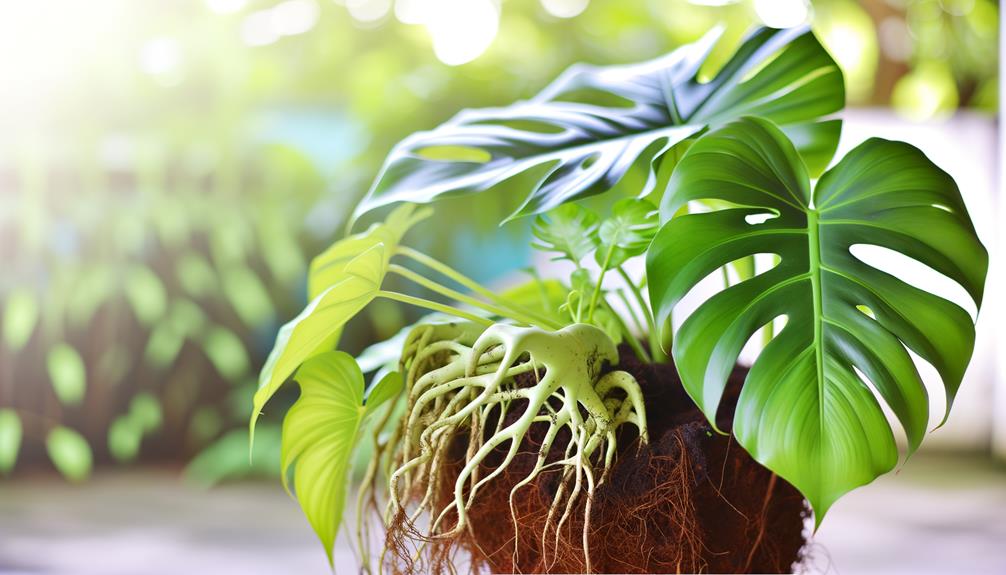
When selecting Monstera dubia for propagation, first assess the plant's overall health, ensuring there are no signs of disease or pest infestation.
Inspect the leaf quality, looking for vibrant, undamaged foliage without discoloration or spots.
Assess Plant Health
Selecting a strong Monstera dubia as a parent plant is essential for successful propagation, so examine the foliage for vibrant color and check for any signs of disease or pest infestations. Look for Phytophthora spp. or Pseudomonas spp., which can cause root rot and leaf spots, respectively. Healthy plants should have firm, green leaves and robust stems. Examine the underside of leaves for pests like spider mites (Tetranychus urticae) and aphids (Aphididae).
| Healthy Indicators | Unhealthy Indicators |
|---|---|
| Vibrant green leaves | Yellowing or browning leaves |
| Firm, robust stems | Wilting or soft stems |
| Pest-free leaves | Presence of pests or eggs |
Ensure the plant is well-watered and receives adequate indirect light, which supports its overall health.
Inspect Leaf Quality
Inspecting leaf quality is vital for maximizing your Monstera dubia propagation efforts. You'll want to choose parent plants with healthy, sturdy foliage to optimize the chances of successful root development.
Pay close attention to the following criteria when examining leaves:
- Color: Look for vibrant green leaves without any signs of yellowing or browning.
- Pests: Check for the absence of pests such as spider mites or aphids.
- Texture: Make sure leaves are firm and not wilted or limp.
- Size: Pick mature leaves that are appropriately sized for Monstera dubia.
- Damage: Avoid leaves with tears, holes, or physical damage.
Check Root Condition
Examine the root system for robustness by looking for thick, white roots without signs of rot or discoloration. Healthy Monstera dubia roots should be firm and turgid, indicating ideal nutrient uptake.
Gently remove the plant from its pot, shaking off excess soil to inspect the roots thoroughly. If you detect brown, mushy, or foul-smelling roots, discard the affected portions using sterilized pruning shears. This prevents the spread of pathogens.
Maximize the root mass has a balanced distribution, avoiding tangled or densely packed areas, which can limit growth. When selecting a parent plant, prioritize those with well-developed, healthy root systems to enhance propagation success.
Your attention to root health directly influences the vigor and resilience of new cuttings.
Identifying Suitable Cuttings
To identify appropriate cuttings for propagating Monstera dubia, each cutting should include at least one node and a healthy leaf for best growth potential. Nodes are essential because they contain meristematic cells, necessary for the development of roots and shoots.
Look for cuttings with:
- A visible node, characterized by a small bump or swelling.
- A healthy leaf, free from pests and diseases.
- Stem segments that are green and firm, indicating vitality.
- Nodes that exhibit aerial roots, enhancing root development.
- Internodes that are relatively short, ensuring compact growth.
Choose cuttings from vigorous parts of the plant, avoiding any with signs of stress or damage. These criteria will maximize your chances of successful propagation and robust growth of Monstera dubia.
Making the Cuttings
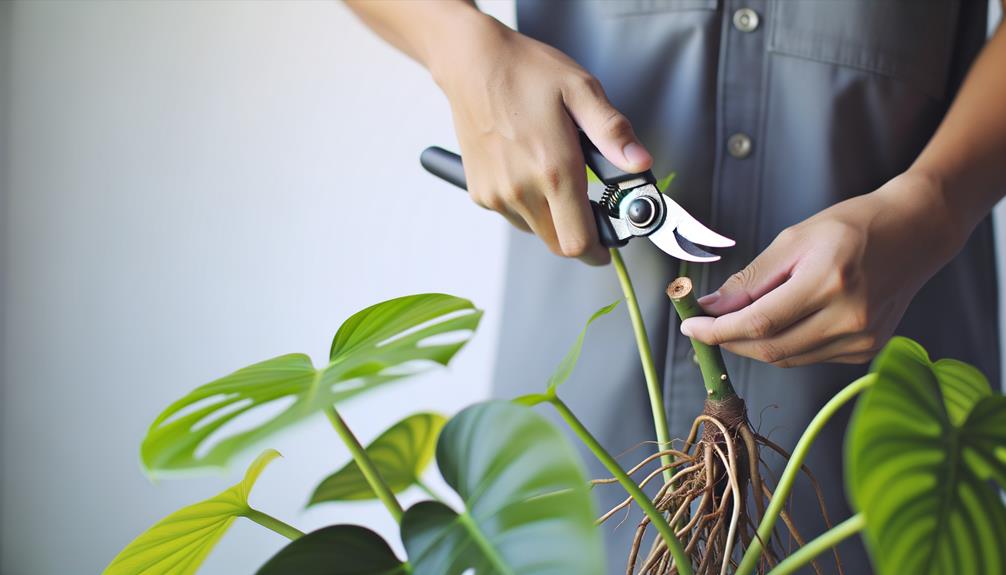
To begin making the cuttings, first identify Monstera dubia stems with at least one healthy node, as nodes are essential for root development.
Use sterilized cutting tools, such as a sharp knife or pruning shears, to prevent pathogen transmission.
Make sure each cutting is approximately 4-6 inches long, including a node and ideally a leaf.
Choosing Healthy Nodes
Selecting healthy nodes is crucial for successful Monstera dubia propagation. This process requires attention to nodes that exhibit firm, green tissue and visible aerial roots. Examine your Monstera dubia (Monstera dubia) plant closely to identify the best nodes for cutting. Focus on sections where the internodes are short, indicating a higher concentration of growth hormones. Guarantee each cutting includes at least one node and one leaf.
- Look for nodes with strong aerial roots.
- Choose sections with vibrant green tissue.
- Avoid nodes showing signs of disease or damage.
- Select internodes that aren't too elongated.
- Ensure the node is firm to the touch.
Sterilizing Cutting Tools
Before making the cuttings, thoroughly sterilize your cutting tools with isopropyl alcohol or a bleach solution to prevent the spread of pathogens. Use a 70% isopropyl alcohol solution or a 10% bleach solution (1 part bleach to 9 parts water). Dip your pruners, scissors, or knife in the solution for at least 30 seconds and let them air dry.
| Sterilizing Agent | Concentration |
|---|---|
| Isopropyl Alcohol | 70% |
| Bleach Solution | 10% (1:9 ratio) |
It's important to maintain tool hygiene because Monstera dubia, like most Araceae, are susceptible to fungal and bacterial infections. Sterilizing your tools minimizes the risk of introducing diseases to the cuttings, ensuring higher propagation success rates. Clean tools make precise cuts, reducing plant tissue damage.
Preparing the Cuttings
When preparing the cuttings for Monstera dubia propagation, make certain you use a sterilized, sharp blade to make a clean cut just below a node. This guarantees a higher success rate for rooting. Select a healthy stem with at least one node and one or two leaves.
Here's what you'll need to do:
- Identify a node: Look for the small, knobby section where roots can emerge.
- Make the cut: Slice just below the node at a 45-degree angle to increase surface area.
- Remove excess leaves: Trim off any extra foliage, leaving only one or two leaves.
- Inspect for pests: Check the cutting for any signs of pests or disease.
- Prepare for rooting: Have your rooting medium ready immediately after cutting.
Following these steps will set you up for successful Monstera dubia propagation.
Rooting in Water
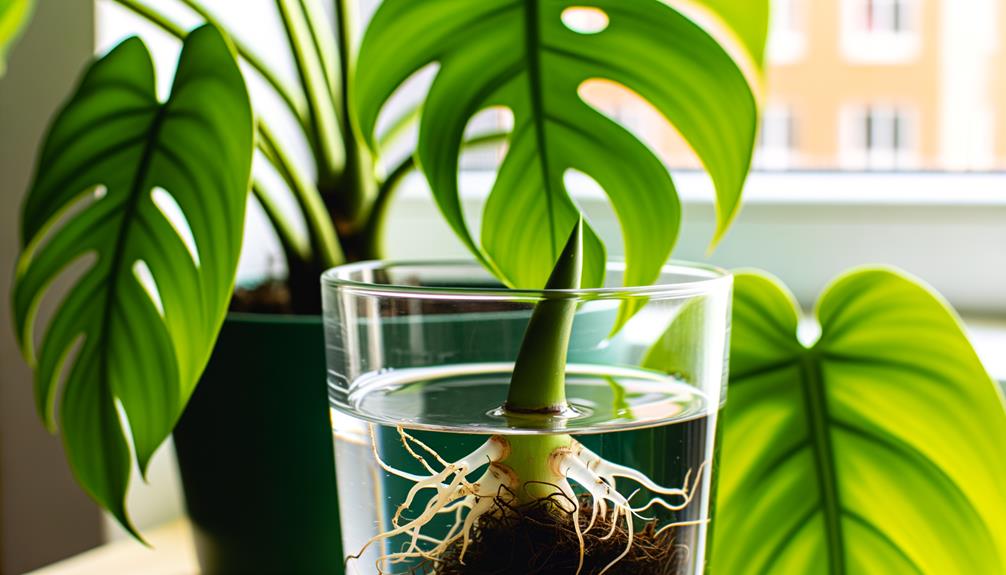
To root Monstera dubia cuttings in water, make sure the node is submerged while keeping the leaves above the waterline to prevent rot.
Fill a clear, glass container with dechlorinated water. Place the cutting in the container, ensuring the aerial roots and node are underwater. Maintain the water level to keep the node submerged. Change the water every 5-7 days to prevent bacterial growth.
Position the container in indirect sunlight, as strong light can damage the cutting. Monitor for root development, which typically occurs within 2-4 weeks. Once roots reach 2-3 inches (5-7.5 cm), transfer the cutting to a suitable growing medium.
This method promotes visible root growth, offering an easy way to track progress.
Rooting in Soil
Wondering how to root Monstera dubia cuttings in soil effectively?
Start with healthy cuttings, each having at least one node. Use a well-draining potting mix, such as a blend of perlite and peat moss. Insert the cutting into the soil, ensuring the node is buried.
Ensure ideal conditions:
- Humidity: Maintain high humidity, ideally above 60%.
- Temperature: Keep the environment between 20-25°C (68-77°F).
- Moisture: Water the soil lightly, avoiding waterlogging.
- Light: Place the cuttings in indirect, bright light.
- Root Development: Check for root growth after 4-6 weeks.
Caring for New Plants

Once your Monstera dubia cuttings have established roots, focus on providing ideal care to promote strong growth and development. Position the plant in a location with bright, indirect light, as direct sunlight can scorch the leaves.
Maintain a consistent temperature range of 18-27°C (64-81°F). Guarantee the substrate remains moist but not waterlogged; use a well-draining soil mix comprising orchid bark, perlite, and peat moss.
Fertilize monthly with a balanced, water-soluble fertilizer (20-20-20) at half strength. Monitor humidity levels, aiming for 60-80%, and mist the leaves regularly to mimic their natural tropical environment.
Support the climbing habit by providing a moss pole or trellis, allowing the plant to attach and ascend naturally.
Troubleshooting Common Issues
Encountering issues with your Monstera dubia can be frustrating, but identifying the problem early guarantees effective intervention and recovery. Assess the plant's environment and conditions to pinpoint the issue.
Here's what to look for:
- Yellowing Leaves: Often caused by overwatering. Check the soil moisture and verify proper drainage.
- Brown Leaf Tips: Typically a sign of low humidity. Increase humidity using a humidifier or misting.
- Slow Growth: Insufficient light is a common culprit. Move your plant to a brighter location, avoiding direct sunlight.
- Root Rot: A result of poor drainage or waterlogged soil. Repot using well-draining soil and a container with drainage holes.
- Pest Infestations: Spider mites and mealybugs can affect Monstera dubia. Treat with insecticidal soap and isolate the plant.
Conclusion
To sum up, propagating Monstera dubia can be a rewarding venture. By following these steps, you'll soon have thriving new plants.
Remember, patience is crucial; roots don't appear overnight. Whether rooting in water or soil, maintain ideal conditions and monitor for common issues like root rot or pests.
With diligence, your Monstera dubia cuttings will flourish, turning your efforts into a lush, green success—truly, 'the proof is in the pudding.'
Happy propagating!



